Canada 2016 "Dinosaurs of Canada II"
| <prev | back to index | next> |
| Issue Date | 26.05.2016 |
| ID | Michel: 3381-3385, Scott: 2923a-2923e, Stanley Gibbons: ?, Yvert et Tellier: 3255-3259 Category: pR |
| Designer | Design: Subplot Design Inc ; Illustrator: Sergey Krasovskiy, Ukraine |
| Stamps in set | 5 |
| Value |
P - Acrotholus audeti P - Troodon inequalis P - Comox Valley Elasmosaur (not a dinosaur, but plesiosaur) P - Cypretherium coarctatum (not a dinosaur, but mammal) P - Dimetrodon borealis (not a dinosaur, but mammal-like reptiles) *P - Permanent TM - $0.85 per stamp is domestic letter rate |
| Emission/Type | commemorative |
| Places of issue | Courtenary, BC |
| Size (width x height) | Mini-Sheet: 160mm x110mm FDC: 191mm x 113 mm Uncut Sheet: 648mm x 481mm |
| Layout | Mini-Sheets of 5 stamps Booklet of 10 self-adhesive stamps |
| Products | FDC x1 |
| Paper | Fluorescent frame |
| Perforation | 13 |
| Print Technique | Offset lithography |
| Printed by | The Lowe-Martin Group |
| Quantity | Mini-Sheet: 140.000; Booklets: 260.000; FDC: 10.000; Uncut Sheets: 2.500 |
| Issuing Authority | Canada Post |

On May 26th, 2016, Canadian Post Authority issued the second set of dinosaur stamps. Similar to the first issue (2015) this one also contain Mini-Sheet of 5 stamps, Booklet with 10 self-adhesive stamps and uncut sheet with 7 Mini-Sheets.
The stylish stamps depict each animal as a reflection in the eye of a predator or in the eye of one of their own species.
Even though the set name is "Dinosaurs of Canada", only 2 of 5 prehistoric animals
featured on this year’s stamps are actually dinosaurs: Acrotholus audeti and
Troodon inequalis.
Elasmosaur is plesiosaur - marine reptile.
Dimetrodon is a mammal-like reptile who went extinct some 40 million years before
the dinosaurs appeared.
Cypretherium is mammal.
"We work with experts in the field from the Canadian Museum of Nature to select dinosaurs that have been discovered in Canada," said Canada Post's media manager Phil Legault. "As with most stamp sets, we also try to select dinos that would make the most stunning and interesting images and represent as many different regions of Canada as possible".
 Even though the set name is "Dinosaurs of Canada", not all of the prehistoric animals
featured on this year’s stamps are actually dinosaurs, but 2 fit the bill.
Even though the set name is "Dinosaurs of Canada", not all of the prehistoric animals
featured on this year’s stamps are actually dinosaurs, but 2 fit the bill. The first is Acrotholus audeti, which roamed Alberta’s Badlands about 84 million years ago.
The second, the small, feathered Troodon inequalis, inhabited the same area some 9 million years later.
The creatures on the 3 remaining stamps are: the Comox Valley Elasmosaur is plesiosaurus (marine reptile) hunted in the waters off what is now Vancouver Island (British Columbia) more than 80 million years ago.
Cypretherium coarctatum nicknamed “Terminator Pig”, bared its menacing teeth to stalk prey on the floodplains of Saskatchewan some 35 million years ago.
Finally, Dimetrodon borealis mammal-like reptiles lived on the arid landscape of Prince Edward Island about 270 million years ago and went extinct some 40 million years before the dinosaurs.
A stylized Dimetrodon, half living creature and half bony skeleton, roams a ferny forest on the booklet’s front cover.
 |
| Acrotholus on stamp of Canada 2016, MiNr.: 3385, Scott: 2923e. |
It contains a single species, Acrotholus audeti. Acrotholus means ‘high dome,’ referring to its dome-shaped skull, which is composed of solid bone over 10 cm thick.
The species name ‘audeti’ honors Alberta rancher Roy Audet, on whose land the best specimen was discovered in 2008. According to the scientists, Acrotholus represents the oldest bone-headed dinosaur in North America, and possibly the world.
The dinosaur walked on two legs and had a greatly thickened, domed skull above its eyes, which was used for display to other members of its species, and may have also been used in head-butting contests.
 |
| Troodon inequalis on stamp of Canada 2016, MiNr.: 3381, Scott: 2923a. |

|
| Troodon's fossil. Image credit: |
It includes at least one species, Troodon formosus, though many fossils, possibly representing several species have been classified in this genus.
These species ranged widely, with fossil remains recovered from as far north as Alaska and as far south as Wyoming and even possibly Texas and New Mexico. Discovered in 1855, Troodon formosus was among the first dinosaurs found in North America.
The genus name is Greek for "wounding tooth", referring to the teeth, which were different from those of most other theropods known at the time of their discovery.
The teeth bear prominent, apically oriented serrations. These "wounding" serrations, however, are morphometrically more similar to those of herbivorous reptiles, and suggest a possibly omnivorous diet.
A partial Troodon skeleton has been discovered with preserved puncture marks.
Comox Valley Elasmosaur
Elasmosaurus is a genus of plesiosaur with an extremely long neck that lived in the Late Cretaceous period, 80.5 million years ago.
 |
| Elasmosaurus on stamp of Canada 2016, MiNr.: 3383, Scott: 2923c. |
The Elasmosaur, whose fossil is displayed in the Courtenay and District Museum and Paleontology Centre, along with a full-sized replica that hangs from the ceiling, was discovered in the fall of 1988.
It was the first Elasmosaur recorded in British Columbia — the first of its kind west of the Canadian Rockies.
Local resident Mike Trask and his 12-year-old daughter Heather were out prospecting for fossils along the Puntledge River just west of the city.
Here is how the Courtenay Museum tells the story:
"Mike was advancing in the lead, kneeling every few meters to examine a particular fossil and to mark it with chalk, for later extraction by Heather following close behind."
Suddenly, as she examined a fossil that her father had just outlined, Heather noticed a group of concretions rising from the exposed shale less than a meter away.
Upon further excavation, both she and Mike were astonished to discover a group of fossilized bones from some great beast, as-yet unknown and extinct since the end of the "Age of Dinosaurs".
Within a year of the marine reptile's discovery, the museum set about to excavate the rest of the animal with staff and numerous volunteers.
Dr. Rolf Ludvigsen led the excavation with about 40 volunteers. Dr. Elizabeth Nicholls of the Royal Tyrrell Museum presided over identification and preparation.
The Courtenay Museum is excited about their ancient creature being chosen by Canada Post for a stamp. "We're very excited about this news. It's a tribute to Mike Trask's Elasmosaur discovery in 1988 and to other significant fossil discoveries made in the Comox Valley." said museum executive director Deborah Griffiths.
Cypretherium coarctatum,, nicknamed “Terminator Pig”, is an extinct entelodont from the Chadronian strata of the Cypress Hills Formation in Saskatchewan.
 |
| Cypretherium on stamp of Canada 2016, MiNr.: 3384, Scott: 2923d. |
Entelodonts lived in the forests and plains where they were the apex predators, consuming carrion and live animals and rounding off their diets with plants and tubers.
They would have hunted large animals, dispatching them with a bite from their jaws. Some fossil remains of these other animals have been found with the bite marks of Entelodonts on them.
Like modern-day pigs, they were omnivores, eating both meat and plants, but their adaptations show a bias towards live prey and carrion.
They were most likely opportunists, mainly eating live animals, but not rejecting carrion and roots and tubers in times of drought.
Dimetrodon
 |
| Dimetrodon borealis on stamp of Canada 2016, MiNr.: 3382, Scott: 2923b. |
 |
| Fossils of Dimetrodon Image credit: CTVnews.ca |
The creatures were top predators in the early Permian era, between 295 and 272 million years ago, and went extinct some 40 million years before the dinosaurs.
Dimetrodons are often mistaken for dinosaurs but are actually more closely related to mammals. A partial skull bone from Prince Edward Island in Canada is the only known fossil of Bathygnathus.
The skull was discovered around 1845 during the excavation of a well in Spring Brook in the New London area.
About design team
The stamp design work was done by Subplot Design Inc. (Vancouver), that included Roy White, Matthew Clark, Steph Gibson and Liz Wurzinger, while the actual illustrations was done by Ukraine-based professional artist Sergey Krasovskiy, who is well known for his dinosaur paintings. |
| Paleoartist Sergey Krasovskiy |
"When I start an illustration, I visualize it in a magazine,” explains Krasovskiy. "I couldn’t do the same with a small stamp, so I printed a stamp-sized frame to actually see the size I was working with."
Steph Gibson came up with the idea of showing the reflection of the creature through the eyes of another. Each eye is a unique frame, so it helps to create an interesting storyline for the stamp. Who’s watching? Predator? Prey? They inspire the imagination without having to depict an entire scene, says Roy White.
"I looked at extreme close-ups of reflections in real eyes, so I could replicate the look with realism." says Sergey Krasovskiy.
The captivating design presented some unusual challenges. The creature needed to appear as a reflection on a curved surface, making it difficult to balance the distortion in the perspective with the very technical – and scientifically accurate – details. For White, the Dinos of Canada issue comes together best when all the products are side by side.
“The repeating eye motif comes roaring back on the uncut press sheet as the eye of a hungry Tyrannosaurus rex and as the frame for a single stamp among seven other souvenir sheets.
It’s not just an illustration to me,” adds Krasovskiy, “I enjoy the process. I hope that it reflects in my work, and that the audience feels that passion.”
Here are some sketches provided by the illustrator, Sergey Krasovskiy.
During the beginning of his work, Krasovskiy started with a design showing Castoroides (an extinct genus of enormous beavers that lived in North America during the Pleistocene). Later on, the "beaver" was replaced by Acrotholus.The early designs consist of drawings of the animals in grayscale. Later on, Krasovskiy would draw the images in color.
On the beginning of his work, Sergey drawn the animals itself. First just grey forms, later on in color.
 |
 |
The next step was to draw eyes and the animals inside.
 |
 |
 |
 |
 |
Finally Acrotholus was depicting on stamp instead of the gigant beaver.  |
 |
 |
 |
 |
 |
|
Products and associated philatelic items
| FDC | Uncut Sheet | |
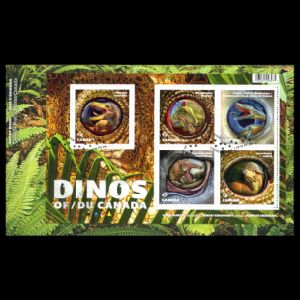 |
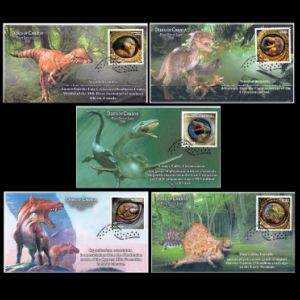 |
 |
| The stamps are cancelled with a pictorial cancellation of dinosaur footprints. The cancel location is Courtenay, British Columbia. The reverse side is here | Personalized set of FDC | The Uncut Press Sheet features 7 copies of the Souvenir Sheet mounted on either side of an image of a dinosaur roaming through a ferny forest. |
| First-Day-of-Issue Postmark | Booklet with 10 self-adhesive stamps | Example of circulated covers |
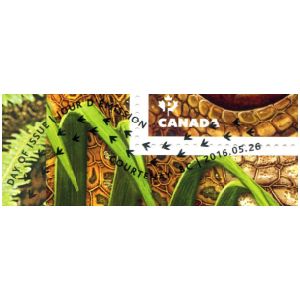 |
 |
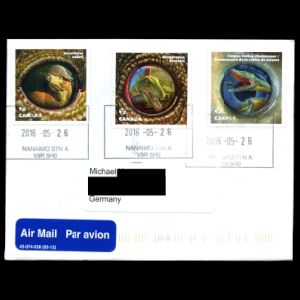 |
| Example of circulated covers | ||
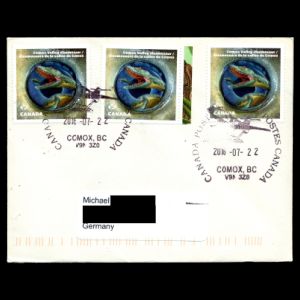 |
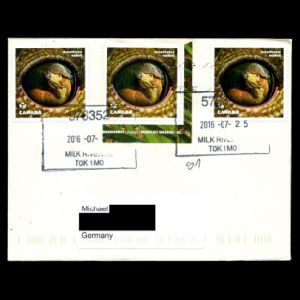 |
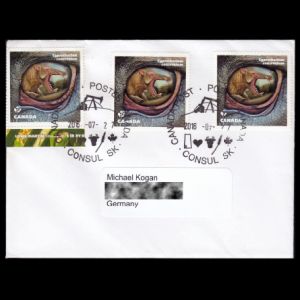 |
| Example of circulated covers | ||
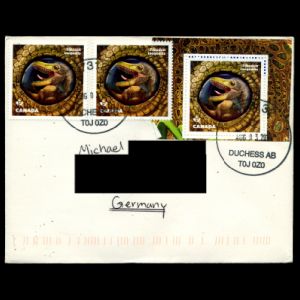 |
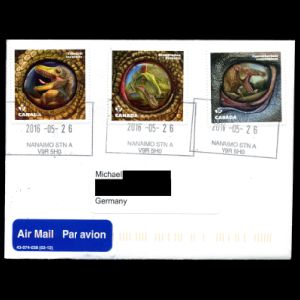 |
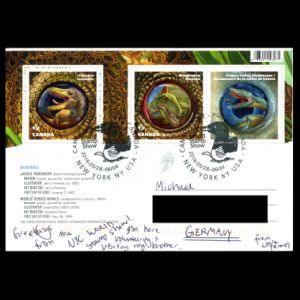 |

|
-
Technical details and description of the stamps:
Canada Post, Details magazine of Canadian Post, SCI News, CTV News, Comox Valley Echo. - Acrotholus: Wikipedia
- Cypretherium:
Wikipedia
- Entelodont Wikipedia
- Dimetrodon: Wikipedia CTVnews.ca
- Elasmosaur: Wikipedia
- Troodon: Wikipedia, phys.org.
- Castoroides giant beaver: Wikipedia
- Sergey Krasovskiy: facebook
Acknowledgement:
- Many thanks to Mr. Sergey Krasovskiy, the illustrator of these stamps for nice conversations via Facebook and for sharing his sketches.
- Many thanks to Dr. Peter Voice, PhD Department of Geological and Environmental Sciences, Western Michigan University, USA, for his help in finding information and for review of a draft of this article.
| <prev | back to index | next> |